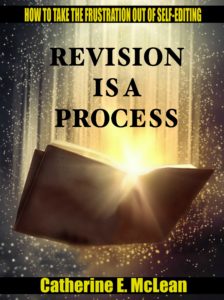Please welcome my guest, fabulous author Catherine E. McLean. Catherine is the author of Revision is a Process. She is sharing her two-part series with us on improving upon writing and taking the frustration out of self-editing. Today her focus will be on clarity. This is a perfect post for November as many authors (including myself) are immersed in National Novel Writing Month (NaNoWri) and can benefit from these writing tips!
Today she discusses how to improve upon clarity. She will return to the blog on November 28th for Part 2 of her series.
William Zinsser/ON WRITING WELL – “Good writing has an aliveness that keeps the reader reading from one paragraph to the next, and it’s not a question of gimmicks . . . It’s a question of using the English language in a way that will achieve the greatest clarity and strength.”
On Writing Well – Clarity and Clutter
Part 1 – Clarity
So, exactly what keeps a reader reading from one paragraph to the next?
What is strength?
To be sure, these things have to do with writing understandable sentences, but for that sentence to be understandable, it must, first of all, have clarity. Take a look at these two sentences:
1) The door chimed as she entered the shop.
2) As she pushed the shop’s door open, it grazed the bell-chimes mounted on the lintel.
Both contain the Red Flag Word “as” but in two different positions in the sentence. Now, which one of the sentences instantly provided you with an image in your mind? Answer—the second one.
But you say, you didn’t see anything wrong with the first one? Let’s look at that sentence.
What’s confusing is that the door is chiming. Doors are usually very solid items, so how could it make a sound other than to creak on its hinges? Logically, a door cannot be a chime or make a chiming sound.
Logically (and never forget your reader is a LOGICAL PERSON), there had to be something else that triggered the chime sound, but what? As written, the reader is forced to guess. (Readers should never be forced to guess incorrectly.) So, what happens if they guess wrong? More than likely, in the reader’s eyes and mind, the story fails to be enjoyable, and the writer has lost credibility.
Secondly, the cause-effect sequence is reversed.
How do I know this? Because of that little Red Flag Word of warning, which is “as.” Nine times out of ten when “as” appears in a clause near the end of a sentence, that sentence has a reversed cause-effect sequence.
What that means is that the mind of the person reading the sentence is forced for an instant to stop and adjust “the movie in the mind” so the passage makes logical sense. After all, isn’t it logical that a person would enter a shop by opening a door and then a chime go off announcing the door’s opening?
Now look again at that second sentence and how the sequence of what happens flows with clarity and logic. The reader can easily visualize what takes place. No stopping, not even for a nanosecond, and no exiting the story world to figure things out or guess. Thus there is strength in the sentence, which keeps the reader reading.
Do yourself a favor and do a search-find for “as”
(type in a space as space, otherwise you’ll find words with as in them like was and tasted, etc.). How many instances of “as” did you find? Do you have crops of (sometimes called “clusters of”) as? Are you overusing the word, after all, if you look in a good dictionary, you’ll find “as” stands in for other words. For clarity, it is best that “as” is not used for a stand-in.
All that repetition aside, and eliminating “as if” and “as ____ as” phrases, what’s left? Likely “as clauses.” Are any “as” clauses at the middle or end of a sentence? Move those to the beginning of the sentence so there is a far better constructed, cause-effect sequence.
If you move the clause to the start of the sentence, or if you find “as” at the start of sentences, look at them anew. Can you reword to eliminate “as” and gain better clarity and imagery for your reader?
I collect statistics from my students and other writers on the total use ratio of “as” (counting ALL uses for “as”). For instance, the fewest uses was 1 “as” every 627 words. The worst statistic so far is 1 “as” every 27 words. Considering an average sentence is said to be 20 words—that’s 1 “as” per sentence.
Now, how about you? What’s your “as” ratio? Please share it with a comment.
ABOUT CATHERINE E. MCLEAN
 Catherine E. McLean’s lighthearted, sci-fi short stories have appeared in hard cover and online anthologies and magazines. Her books include JEWELS OF THE SKY (sci-fi adventure), KARMA & MAYHEM (paranormal fantasy romance), HEARTS AKILTER (a fantasy/sci-fi romance novella), and ADRADA TO ZOOL (a short story anthology). She lives on a farm nestled in the foothills of the Allegheny Mountains of Western Pennsylvania. In the quiet of the countryside, she writes tales of phantasy realms and stardust (fantasy, futuristic, and paranormal) where a reader can escape to other worlds for adventure and romance. She also is a writing instructor and workshop speaker.
Catherine E. McLean’s lighthearted, sci-fi short stories have appeared in hard cover and online anthologies and magazines. Her books include JEWELS OF THE SKY (sci-fi adventure), KARMA & MAYHEM (paranormal fantasy romance), HEARTS AKILTER (a fantasy/sci-fi romance novella), and ADRADA TO ZOOL (a short story anthology). She lives on a farm nestled in the foothills of the Allegheny Mountains of Western Pennsylvania. In the quiet of the countryside, she writes tales of phantasy realms and stardust (fantasy, futuristic, and paranormal) where a reader can escape to other worlds for adventure and romance. She also is a writing instructor and workshop speaker.
Website: http://www.CatherineEmclean.com
Website for Writers: http://www.WritersCheatSheets.com
Blog: https://writerscheatsheets.blogspot.com
Email: catherine@CatherineEmclean.com
Facebook https://www.facebook.com/catherine.e.mclean.5
Twitter: https://twitter.com/#!/CatherineMcLea7
Links for REVISION IS A PROCESS:
Amazon.com – https://www.amazon.com/dp/0988587440
Barnes & Noble – http://www.barnesandnoble.com/w/revision-is-a-process-catherine-e-mclean/1126295618

Great post! Excellent advice. This same cause/effect issue happens a lot when using ‘when’ or ‘after.’ I try to catch them in my writing, but don’t always. Thanks for the reminder!
Hi, Alicia. You’re right about ‘when’ and ‘after’ being culprits in skewing cause-effect. That’s because the two words are actually meanings for AS. When I do feedback for others, I often flag an AS-clause and write in ‘when’ or ‘after’ because it clarifies meaning. And yes, often that clause has to be moved to the front of the sentence, but sometimes substituting the correct word for AS does the trick and the clause remains at the end of the sentence. Since you find yourself missing some instances of the two words’ uses, consider setting up a Master Red Flag Word List with them, and other words, that you need to check for. During your self-editing process, you can look for one word at a time (do a global search-find) and be confident you achieved clarity. By the way, currently available at my Writers Cheat Sheet website is a free download for “10 Red Flag Words.” Thanks for stopping by and have a great Tuesday.
Makes sense…thank you! I’ll check it out. I appreciate the advice!
Hi Catherine,
Really enjoyed this article! I am moving away from “as” but still overuse it at times. Same with when and after. Excellent reminder!
Amy
Thank you for stopping by!
Wow…great things to keep in mind as we continue to develop our craft!
Thanks for sharing
Good luck and God’s blessings
PamT
You are very welcome and keep learning and growing as a write and storyteller.
Great advice! The cause and effect sequencing can really make a reader stumble.
So true. Yet, it’s in the revision process that we have the opportunity to look at the words and make them “the right ones.” Thank you for commenting. Have a great week.
Maureen, thank you for having me as your guest today. I look forward to returning November 28 with the second part on Clutter. May you and your followers enjoy a Happy Thanksgiving.
In a creative nonfiction writing group at Cleveland State University, one writer chanted, “Don’t break the flow.” Now I understand. Strong writing lets the reader visualize action without pausing for even a nanosecond. Thanks for clarifying, Catherine.
Catherine- thank you for sharing such great tips! I look forward to your next guest post.